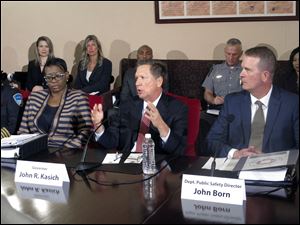
Ohio urging police agencies to meet new statewide standards
1/14/2017COLUMBUS — Ohio is urging state law enforcement agencies to adopt new standards governing the use of deadly force, body cameras and other policies ahead of a March deadline, or risk community backlash.
An advisory board commissioned by Gov. John Kasich created the standards after a series of fatal police shootings, including the 2014 death of 12-year-old Tamir Rice in Cleveland.
The goal of the standards is to create trust between police departments and the communities they serve, said John Born, director of the state’s Department of Public Safety.
“This wasn’t about fixing law enforcement, or fixing communities,” Born said. “This was an equal and a shared responsibility.”

In 2015, Ohio Gov. John Kasich announced a plan to establish the first-ever statewide police standards for the proper use of force, recruiting and hiring.
Individual police officers in Ohio have had to meet a minimum set of statewide training standards for decades. This is the first time departments themselves must also meet a basic set of state policies. Other standards govern recruiting, hiring and dispatching. The standards were developed by a racially mixed group that included police officers, a minister, a mayor, a civil rights advocate and others.
There’s no punishment for agencies that don’t adopt the policies, but those that don’t will be labeled as noncompliant on a list to be published in March.
The hope is that communities will demand answers from those that aren’t on the list, said Born, a longtime state trooper before becoming public safety director.
With two months before the deadline, about 325 agencies employing about 22,200 officers — or six in 10 of every police officer in the state — have received or applied for certification.
Departments are quickly applying to make the deadline, and Born said the hope is agencies employing about two-thirds of all officers will be on board by March.
To date, some of Ohio’s biggest police agencies have received certification or expect to by March. Those include the Cincinnati and Columbus police departments, the Akron, Dayton and Toledo departments, and the highway patrol.
Dozens of smaller departments are also participating, including one-person agencies in American Township in western Ohio and Waynesfield in northwestern Ohio; 25-person departments such as the Franklin police in southwestern Ohio and the Hocking County Sheriff’s Office in southern Ohio; and several university departments, including Miami University, Shawnee State and Case Western Reserve.
“The time to connect with your community and to become transparent isn’t after there’s a problem,” said Mark Denney, chief of the 54-person Colerain Township police department in suburban Cincinnati, one of the agencies that has already adopted the standards.
“You need to be ahead of it and understand that you have to build trust first for when that time comes that there’s a question,” Denney said.
But some agencies are opting out, seeing the standards as duplicating things already in place or too much work at a time when staffing is tight.
In Steubenville in eastern Ohio, Chief William McCafferty said his department met the standards in negotiations with the U.S. Justice Department years ago.
McCafferty also says the state is asking departments to spend precious time and energy on the program after cutting local government funds that could have helped. Those cuts cost the 39-officer Steubenville agency nine positions, he said.
“I understand what they’re trying to do, but they’ve saved a lot of money by cutting funding to the cities. If their hearts are really in it, they would provide more assistance in this process,” McCafferty said in an interview.
Born insists the program is not a top-down mandate, but instead a way of setting a shared goal for law enforcement agencies and the communities they serve.
“This is a consequence that your community’s going to hold you accountable, which is where the responsibility should lie,” Born said.